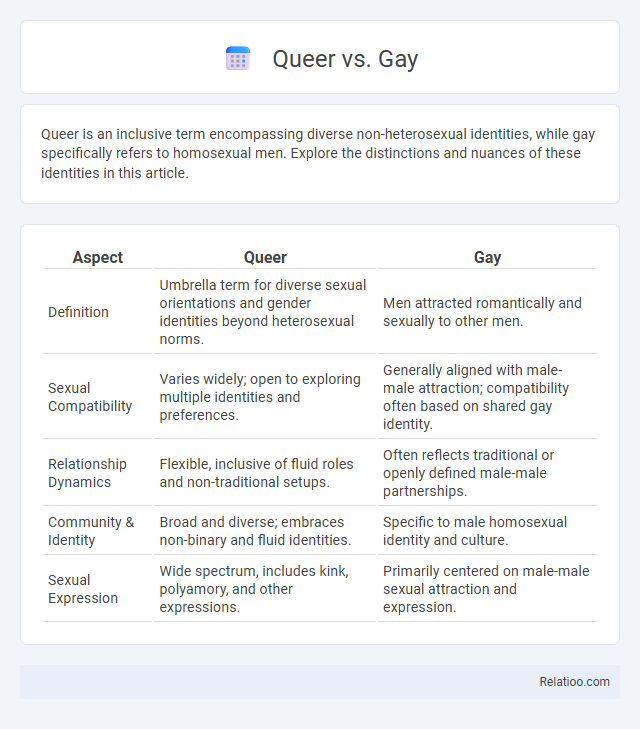Queer is an inclusive term encompassing diverse non-heterosexual identities, while gay specifically refers to homosexual men. Explore the distinctions and nuances of these identities in this article.
Table of Comparison
| Aspect | Queer | Gay |
|---|---|---|
| Definition | Umbrella term for diverse sexual orientations and gender identities beyond heterosexual norms. | Men attracted romantically and sexually to other men. |
| Sexual Compatibility | Varies widely; open to exploring multiple identities and preferences. | Generally aligned with male-male attraction; compatibility often based on shared gay identity. |
| Relationship Dynamics | Flexible, inclusive of fluid roles and non-traditional setups. | Often reflects traditional or openly defined male-male partnerships. |
| Community & Identity | Broad and diverse; embraces non-binary and fluid identities. | Specific to male homosexual identity and culture. |
| Sexual Expression | Wide spectrum, includes kink, polyamory, and other expressions. | Primarily centered on male-male sexual attraction and expression. |
Understanding the Terms: Queer vs Gay
Queer is an inclusive term encompassing diverse sexual orientations and gender identities, often used as an umbrella for non-heteronormative identities. Gay specifically refers to individuals attracted primarily to the same gender, most commonly men attracted to men. Understanding the distinction between queer and gay is essential for respectful communication and accurate representation within LGBTQ+ discussions.
Historical Origins of ‘Queer’ and ‘Gay’
The term "queer" emerged in the late 19th century as a derogatory label, but it was reclaimed by the LGBTQ+ community in the late 20th century to signify a broad and inclusive spectrum of sexual and gender identities. "Gay" specifically originated in the early 20th century, initially meaning "joyful" before becoming a widely accepted term for homosexual men by the mid-20th century. Understanding these historical origins helps you appreciate how the meanings of "queer" and "gay" have evolved, reflecting shifts in social attitudes toward sexual orientation and identity.
The Evolution of Queer Identity
Queer identity has evolved from a marginalized term to an inclusive umbrella encompassing diverse sexual orientations and gender identities, reflecting fluidity beyond the fixed labels of gay, lesbian, or bisexual. Understanding the distinctions between queer, gay, and sexual orientation helps you appreciate the complexity and spectrum of human identity and attraction. The ongoing redefinition of queer challenges traditional norms, promoting acceptance and visibility within LGBTQ+ communities worldwide.
Gay Identity: Meaning and Representation
Gay identity refers to individuals who are romantically and sexually attracted to people of the same gender, primarily used to describe men but inclusive of all who identify with this orientation. It represents not only a sexual orientation but also a cultural and social identity that encompasses shared experiences, history, and advocacy within the LGBTQ+ community. Understanding gay identity helps your awareness of diverse sexual orientations and promotes inclusivity and respect for all expressions of love and attraction.
Inclusivity: Queer as an Umbrella Term
Queer serves as an inclusive umbrella term encompassing diverse sexual orientations and gender identities, including gay, lesbian, bisexual, transgender, and non-binary individuals. It promotes acceptance and visibility by challenging rigid categories and embracing fluidity within the LGBTQ+ community. Utilizing queer fosters a broader understanding of identity beyond traditional labels, enhancing inclusivity in social, cultural, and political contexts.
Language, Labels, and Self-Identification
Queer serves as an inclusive, umbrella term encompassing diverse identities beyond traditional labels like gay, which specifically denotes attraction to the same gender. Sexual orientation refers to an individual's enduring pattern of emotional, romantic, or sexual attraction, often expressed through self-identification using terms such as gay, lesbian, bisexual, or queer. Language and labels in LGBTQ+ communities evolve to reflect personal experiences, cultural contexts, and political identities, emphasizing respect for how individuals choose to define themselves.
Community Perspectives: Queer vs Gay
Queer is an inclusive and flexible term embraced by diverse communities to challenge traditional norms and encompass a variety of sexual orientations and gender identities, often emphasizing political activism and intersectionality. Gay specifically refers to individuals attracted to the same gender, primarily men, and holds a more defined identity within the LGBTQ+ spectrum. Community perspectives distinguish queer as a broader, evolving identity while gay maintains historical specificity and cultural consolidation in advocacy and social support.
Intersectionality in Queer and Gay Experiences
Queer and gay identities intersect with multiple social categories including race, gender, and class, influencing the lived experiences of individuals beyond sexual orientation alone. While "gay" specifically denotes attraction to the same gender, "queer" offers a broader, more inclusive framework that challenges normative boundaries of identity and embraces fluidity. Intersectionality sheds light on how overlapping systems of oppression and privilege shape unique challenges and resilience within queer and gay communities.
Usage in Media, Academia, and Activism
Queer, gay, and sexual orientation represent distinct but overlapping identities frequently examined in media, academia, and activism. Media often uses "gay" narrowly to describe attraction to the same gender, while "queer" serves as an inclusive and flexible term encompassing diverse non-heteronormative identities. Academia emphasizes the fluidity and political dimensions of "queer" theory, whereas activism employs both terms strategically to advocate for varied LGBTQ+ rights and visibility, helping Your understanding of identity complexity.
Choosing the Right Term: Respect and Awareness
Understanding the distinctions between queer, gay, and sexual orientation fosters respect and awareness in personal and social contexts. Queer serves as an inclusive umbrella term for diverse sexual identities, while gay specifically refers to same-gender attraction, and sexual orientation defines one's inherent romantic or sexual preference. Using the right term reflects your acknowledgment of individual identity and promotes respectful communication within LGBTQ+ communities.

Infographic: Queer vs Gay
 relatioo.com
relatioo.com